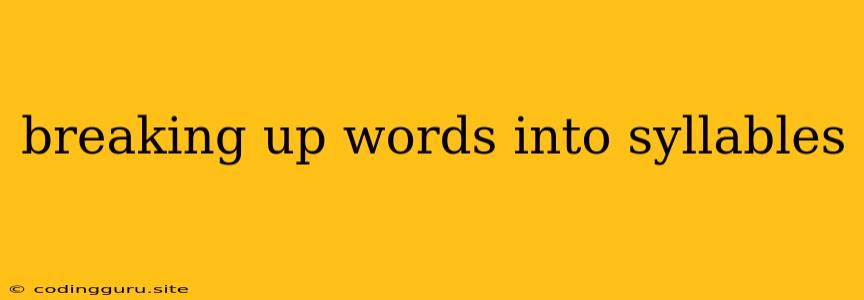Breaking Up Words into Syllables: A Guide to Understanding the Building Blocks of Language
Breaking words into syllables is a fundamental skill in language learning and development. Understanding how syllables work can help you improve your pronunciation, reading fluency, and overall comprehension of language. But what exactly are syllables?
What is a Syllable?
A syllable is a unit of pronunciation that consists of a single vowel sound, with or without surrounding consonants. It's the basic building block of a word, and it's what makes a word sound the way it does.
How to Break Down Words into Syllables:
Here's a simple guide to breaking down words into syllables:
- Identify the vowels: Start by identifying the vowels in the word. Remember, vowels are the sounds you make with your mouth open: a, e, i, o, u.
- Count the vowel sounds: Count the number of vowel sounds you hear when you pronounce the word.
- Divide between vowel sounds: Each vowel sound typically forms a separate syllable.
Common Syllabication Rules:
While the basic principle is simple, there are some general rules that help us break down words more accurately:
- One syllable per vowel sound: Words like "cat," "dog," and "run" have one vowel sound and therefore one syllable.
- Consonant blends and digraphs: When consonants come together, they are usually part of the same syllable, such as "bl," "ch," "sh," and "th."
- Silent letters: Silent letters are not counted when determining syllables. For example, the word "knife" has one syllable, even though it has five letters.
- Diphthongs: Diphthongs, which are two vowel sounds blended together (like "oi" in "boy"), typically form a single syllable.
Tips for Breaking Down Words:
- Practice: The more you practice, the better you'll become at identifying syllables.
- Say the word out loud: Hearing the word helps you understand its sound structure.
- Use a dictionary: Many dictionaries provide syllabication information.
- Look for patterns: Try to recognize common syllable patterns in words.
Why is Syllabication Important?
Understanding syllables is crucial for a variety of reasons:
- Pronunciation: Breaking down words into syllables helps you pronounce them correctly.
- Reading fluency: Syllabication can improve your reading speed and accuracy.
- Spelling: Knowing how to divide words into syllables can help you spell them correctly.
- Understanding language: Syllabication helps you analyze the structure of words and understand how language works.
Examples of Breaking Down Words into Syllables:
- "Cat" - 1 syllable
- "Dog" - 1 syllable
- "Run" - 1 syllable
- "Water" - 2 syllables (wa-ter)
- "Elephant" - 3 syllables (el-e-phant)
- "Butterfly" - 3 syllables (but-ter-fly)
Conclusion
Breaking down words into syllables is a valuable skill for language learners and everyone who wants to improve their understanding and use of language. By practicing these basic rules and tips, you can become more proficient in identifying syllables and using them to enhance your reading, writing, and communication skills.
